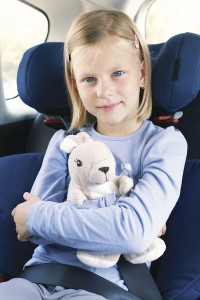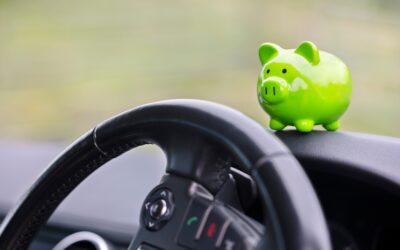Sadly, road traffic accidents are all too common and it comes as no surprise that booster seat laws reflect the seriousness of this issue by having strict guidelines in place for how children should be safely restrained when they are travelling by car. And it’s not just small children and babies that are covered by the law, change to booster seat laws over the last 10 years have seen children up to the age of 12 become subject to child car seat safety guidelines.
Booster seat law: When do you need a child car seat?
 The law in this area is very clear. If a child is travelling in the front or rear seat of any car, goods vehicle or van then you must use the appropriate child car seat until they are 12, or they are 135cm in height, whichever comes first and they must never travel on your lap.
The law in this area is very clear. If a child is travelling in the front or rear seat of any car, goods vehicle or van then you must use the appropriate child car seat until they are 12, or they are 135cm in height, whichever comes first and they must never travel on your lap.
After that, they must use an adult seat belt. It is the responsibility of the driver to ensure that children under 14 have the correct restraints as dictated legally and thereafter responsibility devolves to the passenger.
Any penalties incurred for not having a child properly restrained can have severe consequences, such as a fine, points on your licence and increased car insurance costs. Getting cheaper car insurance is not always easy and any penalties are not going to help.
High backed booster seats and cushions: Which one do I need?
There are two types of booster seats; backless booster cushions, and high back booster seats. Both types of booster seats are designed to make children sit higher in a car, with their shoulders in a closer position to that of an adult, allowing them to use the car’s seat belt.
High backed booster seats
Changes to booster seat laws in February 2017 mean that new booster seats must have high backs for children between 15kg and 22kg (or 125cm).
High backed booster seats are better able to route the seat belt around the child’s body.
Backless booster cushions
Backless booster cushions are now only being manufactured for children weighing 22kg and over (around age 7).
Unlike high backed booster seats, booster cushions do not have backs, which mean that while they keep the child restrained, they do not offer any additional side impact protection.
It is not illegal to use a booster cushion for a child weighing under 22kg if you already own one, and there are currently no plans to make high backed booster seats compulsory for children over this weight either. Although the evidence suggests that high backed booster seats provide better protection than booster cushions, a booster cushion is still better than no booster seat at all.
Baby car seat laws
Babies weighing under 9kg, or approximately 9 months old, should always travel rear facing, in an infant child carrier.
Facing rearwards offers better head and neck protection, and infant child carriers position the baby so they are lying relatively flat. This stops their head flopping forwards when they fall asleep. Lots of car seats are combination ones, i.e. they can be used forward and rearward facing, with different levels of tilt. This means they can be adjusted as the child grows, providing a good investment for what can be a fairly significant amount of money.
Present laws state that once the baby reaches 9kg, they can travel in a Group 1 forward facing seat, however being rear facing continues to offer better protection for your baby even after they reach this size.
I-Size legislation, which runs alongside the current laws, sees car seats measured by height, rather than weight, and requires babies using rearward-facing restraints until they are at least 15 months old. Although it is not law yet, it is expected that existing baby seat laws will be gradually replaced by the i-size standard in future.
Car seat groups and ages
Children should travel in a car seat that is suitable for their weight, under ECE regulation R44 (R44/03 or R44/04), or for their height under the new i-size regulation R129. Car seats meeting either of these standards should display the ‘E’ mark on the seat. Although manufacturers will give an age range for which the seat is likely to be suitable for, it is the weight or height of the child that is important. The table below shows at a glance which type of weight based car seat is suitable for which age.
| Age Range | Weight Range | Type of Child Restraint |
| Birth to 6-9m
Birth to 12-15m |
0-10 kg (Group 0)
0-13 kg (Group 0+) |
Rearward-facing baby seat |
| Birth to 4 years
Birth to 6 years |
0-18 kg (Group 0+ & 1)
Birth – 25kg (Group 0, 1 & 2) |
Combination seat (forward and rearward facing) |
| 9m to 4 years | 9-18 kg (Group 1) | Forward facing |
| 1 to 11 years | 9-36 kg (Groups 1, 2 & 3) | Forward facing |
| 4 to 6 years | 15-25 kg (Group 2) | High backed booster seat |
| 4 to 11 years
4 to 11 years |
15-36 kg (Groups 2 & 3)
15-36 kg (Groups 2 & 3) |
High backed booster seat
Booster cushion |
| 6 to 11 years | 22-36 kg (Group 3) | Booster cushion |
Car seat law exceptions
The law on child restraints whilst travelling by car is strict, but there are also exceptions.
- If a restraint is not available in a private hire vehicle or a licensed taxi, then a child can travel in a rear seat, using an adult seat belt if they are aged 3 or older, or without a seatbelt if they are aged under 3.
- Children may travel in a coach without a child car seat or seat belt if they are not available.
- Children must travel in the rear seats of minibuses. Those aged 3 or over must use a child car seat if available, or an adult seat belt if they are either unavailable or not suitable.
- If a journey is unexpected, necessary and over a short distance, a child aged 3 and over can travel using an adult seatbelt. Children aged under 3 can only make an unexpected journey in the back of a taxi, and should not use an adult seatbelt when doing so.
- If two occupied child restraints prevent the fitting of a third, then a child can travel using just adult restraints if they are aged 3 or over. If all three children are aged under 3, one must travel in the front seat using a suitable child seat.
- If the vehicle has no seat belts, children under 3 cannot travel. Children 3 and over can travel in the back seat without a car seat or seat belt if the vehicle doesn’t have one.
Quite rightly, the focus of the law is on keeping children in cars safe and reducing the number of deaths caused by road traffic accidents each year. Because of this, legislation is constantly changing, so it is important to make sure you keep up to speed with the latest requirements.
So if you have a child’s car seat fitted in your vehicle and you are involved in an accident, or if it is damaged following a fire or theft, and you are insured with Go Girl, we will pay towards the cost of a replacement seat even if it doesn’t appear to be damaged. For more information, please refer to the policy wording.



